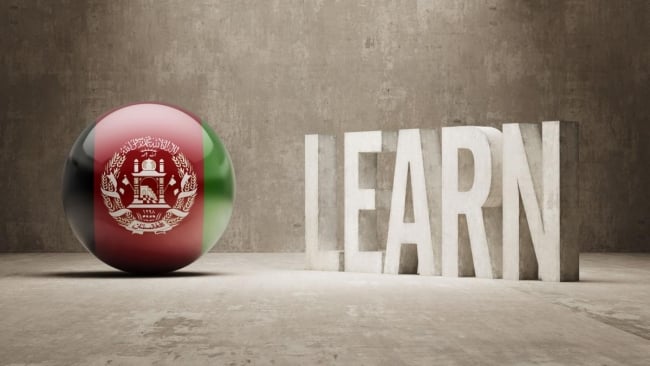You have /5 articles left.
Sign up for a free account or log in.

XtockImages/istock/getty images plus
Since the Taliban takeover of Kabul last summer, higher education in Afghanistan has been thrown into disarray. International universities and colleges have raised millions of dollars to rescue scholars and help others at particular risk. But the vast majority of Afghan students now face the prospect of attending universities where many of their faculty have fled and where censorship prevents the type of dialogues that are essential to develop critical thinking.
What can international students and scholars, working with their Afghan counterparts, do about this? We decided to start with one single class and build from there.
The 30 boxes on our Zoom screens represented students who were in eight different countries and speaking 15 languages, as well as three scholars located on opposite sides of the globe. The boxes also represented an experiment that asked, how can we teach and learn about Afghanistan in a critical, interdisciplinary way that brings together Afghan scholars and students, as well as other people, despite the near collapse of higher education in Afghanistan? How can students think about and discuss their country and global politics in a way that is more complex than the overly simple stories we see in the media?
And while this was one class, with a handful of students speaking to each other and to visiting scholars online, it also suggests some of the ways that we can support Afghan students despite Taliban restrictions that have stifled higher education in the country.
The fall of the government led by Ashraf Ghani and the return of the Taliban in Afghanistan in August 2021 has triggered an economic collapse and humanitarian crisis. Less noted upon, it has also created a crisis for higher education in Afghanistan. Students at the American University of Afghanistan fled or went into hiding. Students at other universities wondered if they would be able to continue their studies, and the months since have only seen more restrictions from the Taliban—including the recent declaration that women must be fully covered and with a male escort when leaving the home.
Such shifts are particularly tragic, as higher education has been one of the few areas that had seen real growth in Afghanistan over the past 20 years—with new universities opened, hundreds of thousands of young Afghans studying domestically and many young Afghan scholars making a name for themselves internationally. The growth of subject areas such as law, journalism and art provide avenues for women in particular. For both those involved in Afghan higher education and Afghan students themselves, there are now few easy solutions. Universities stopped paying faculty, women were turned away at the gates and, for a while, it was not even clear that classes would resume. Many scholars fled, many Afghan students stayed home and many in the international community were at a loss for what they could do to help in a moment like this.
In the ensuing months, American higher education institutions, like the University of Pittsburgh and Princeton University, developed or expanded programs focused on Afghanistan. Those programs provided displaced scholars important opportunities to continue their work. But as students and scholars at less well-funded institutions, we also wanted to do what we could. In particular, we began to ask, what would it look like to try to actively support students in Afghanistan while also providing students outside the country with a new lens for seeing it?
Our course began as a series of emails and conversations between faculty and students at Bennington College and the American University of Afghanistan, as well as with scholars at almost a dozen other institutions. Speaking with young Afghan students—in particular, those who had benefited the most from some of the advances in higher education in Afghanistan—it seemed clear that amid the regressive practices of the Taliban, students still wanted to learn and debate and engage with each other. Many also had a strong sense that the international media and politicians were not hearing their experiences or understanding that there was more than one way of looking at Afghanistan. We ultimately offered a joint experimental course with the American University of Afghanistan to 40 students, who could participate synchronously or asynchronously, that we called Approaches to Afghanistan, led by one of us, Noah Coburn, and Muska Dastageer at AUAF.
Bringing in Many Voices
The majority of students were Afghans, many of whom were still in Afghanistan, but others had been displaced and were living in over a dozen different countries (with about a third in the United States, a third in Afghanistan and a third elsewhere). Bennington students from a range of countries also attended. As a result, we had an incredible diversity of perspectives, knowledge and experiences in every Zoom session. That could make some things difficult to navigate, and the course certainly did not always progress smoothly. Even simple decisions in the class had deeper implications. For example, some students kept their cameras on, but many—particularly in Afghanistan—did not due to security concerns or simply the fact that their internet bandwidth wasn’t strong enough to keep the video feed working. Students were allowed to use pseudonyms throughout the course, and when the internet was unreliable in Afghanistan, we made transcripts of class sessions available for those who needed them. All this created a constant awareness of the spaces we occupy physically outside the common virtual space of a class.
Navigating cultural differences was also a challenge; we encountered some simple differences, such as the formality with which Afghan students address the professor in contrast to the less hierarchical first-name basis that Bennington students rely upon. Sometimes, particularly around politically and socially sensitive areas, Bennington students were reluctant to jump into the conversation. For their part, they sometimes felt they did not have the experience with Afghanistan to comment meaningfully.
The makeup of the class meant that almost every topic had deeply personal implications for students, which shaped the contours of our conversations, but we also pushed each other to think analytically and avoid overly simple answers. For instance, Sonia Ahsan-Tirmizi, a lecturer in Middle Eastern, South Asian and African studies at Columbia University, gave a lecture on the politics of women’s shelters in Afghanistan. The ensuing classroom discussion ranged back and forth between how we intellectually understand different types of feminisms to the personal experience of being a woman living under the new Taliban regime.
However, many students told us that the real strength of the course was the interdisciplinary approach of bringing in scholars, mostly Afghans or of Afghan descent or with long ties with the country from different fields, who represented a range of disciplines—including political science, anthropology, history, media studies and others. That, in many ways, was very typical for a Bennington classroom, where we don’t have departments or majors, and such interdisciplinary approaches were particularly valuable in this context where so much of the discussion of Afghanistan has been reductionist and overly simplified. As one Afghan student observed, “This class showed how Afghanistan is shaped through wonderful culture and heritages. We have to understand the country through different means and how it portrays the identity of an Afghan. Thus, this class made me realize how we can research and use different methods to fully understand a culture that shapes a society and identity.”
Together, the scholars showed deep understanding the country and the ways in which the Western paradigms miss some of the most important aspects of Afghan life. Haroun Rahimi, assistant professor in the law department at the American University of Afghanistan, discussed informal economic transactions and how they provide support for many Afghans that could be missed in more macroeconomic analyses, for example. And in a time when so much of Afghan daily life has become politicized, several students discussed how presentations on cultural history that united rather than divided Afghans were meaningful. For instance, Annika Schmeding, a cultural anthropologist and junior fellow at the Harvard Society of Fellows, explained how Sufi networks in Afghanistan offer alternative modes for being Muslim with deep historical roots in many of Afghanistan’s cities.
In each case, we asked scholars to speak to their own backgrounds and how they came particularly to the field and methods that they use today. For example, Mejgan Massomi from the Stanford University Center for South Asia talked about how growing up listening to Ahmad Zahir and other Afghan musicians from the 1970s with her parents led her to study history and music. Zahir’s innovative music, bringing together elements from South Asia and beyond to create a hybrid musical form that is distinctly Afghan, also suggested ways of creating an Afghan identity outside the current divide between the Taliban and other groups. All the presentations and discussions showed students how their own backgrounds and interests could propel their scholarly pursuits as well as new ways of thinking about the country.
The variety of speakers allowed students to take different things from each session, and the design of the course acknowledged that students were in very different situations, so they could participate synchronously or asynchronously. Much of the online discussion happened in Slack, where students could post when they could comment even if they were having trouble connecting with the live discussions.
Students were ultimately asked to design their own project that looked at some specific issue in Afghanistan and to articulate their individual approach to understanding the country. In this small way, students were able to practice their own interdisciplinary thinking skills as well as develop their own perspectives about Afghanistan in a more nuanced way than media accounts. One Bennington student told us, “Taking this course checked many biases. We are devoid of a multifaceted Afghanistan, one that deserves its own lexicon beyond our preconceived ideas and the fixations of popular media. This course became a reminder to learn beyond our isolated scholarships, especially when engaging with a context dissimilar to ours.”
Helping Afghan Higher Ed Go Forward
In the months after the withdrawal of U.S. troops in Afghanistan, we’ve seen an outpouring of support from many generous American and international educational institutions. They have taken in scholars and students who have been displaced and allowed them the opportunity to continue their work. But much more needs to be done. Since our course began, things have become worse, not better for many of the students in Afghanistan. Many students feel the opportunities for continuing in the country are not there. Women, for instance, are now barred from campus administrative buildings, and one of the female students in our class had to send her brother to register her for classes.
Higher education internationally cannot solve these issues, especially since the U.S. government has not recognized the Taliban, and working with universities under Taliban control raises numerous challenges. Yet, at the same time, there is a world of technology under this Taliban regime that simply did not exist when they first isolated the country in the 1990s. Zoom, YouTube, Slack and many other platforms can be used to create both conversations and complete courses.
Afghan students, for instance, have expressed a desire for more courses that apply directly to Afghanistan, such as art history and environmental science, as well as others in demand, like computer science and journalism, that could help Afghans develop skills that current Taliban-controlled universities are not teaching well. International universities could even take a consortium approach and collaborate on developing entire curricula. Ultimately, not only Afghan students but also American and international students can benefit much from these intercultural exchanges and learn that countries like Afghanistan are far more than what is shown on the news.




